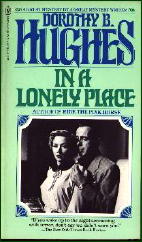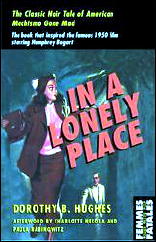Sun 28 Feb 2010
A Review by Tina Karelson: DOROTHY B. HUGHES – In a Lonely Place.
Posted by Steve under Reviews[4] Comments

DOROTHY B. HUGHES – In A Lonely Place. Duell Sloan and Pearce, hardcover, 1947. Paperback reprints include: Pocket #587, 1949; Bantam 1979, Carroll & Graf, 1984; Feminist Press, 2003.
Film: Columbia, 1950. Humphrey Bogart (Dixon Steele), Gloria Grahame (Laurel Gray), Frank Lovejoy (Det. Sgt. Brub Nicolai).
If you’ve seen the movie, which happens to be one of my favorites, know this: the book is completely different, but even better.
Set in post-war L.A., the story is told in the third person, entirely from the point of view of Dix Steele. Dix is one of the lost men — someone who thrived in uniform, in danger, but who is now adrift, pretending to be a writer but living mostly on remittances from a wealthy uncle.
When beautiful divorcee Laurel Gray comes into his life, he falls deeply in love and begins to heal, just a little. But Laurel begins to fear Dix, and she takes her concerns to Dix’s friend Brub Nicolai and his astute wife Sylvia. An old war chum of Dix’s, Brub is now an L.A. cop investigating a series of strangulation murders.

As a crime story, this book starts out chillingly and compellingly, and becomes more so with each passing page.
As a piece of social fiction, it paints a fascinating picture of post-war America, contrasting the disenchantment and isolation of some returning soldiers with the orderly, energetic, sociable world of recognizable “Greatest Generation” types like the Nicolai’s, who successfully fought a war and now want to build an orderly, peaceful world at home and also value having a good time — driving, dining, drinking and dancing.
The prose is Hemingway-esque in its spareness. The integrity of the POV is scrupulous.
This is one of the great American novels of the mid-20th century. If Hughes isn’t taught in colleges, she should be.
February 28th, 2010 at 9:50 pm
Hughes is perhaps the most under-rated writer of her era. Aside from the books made into excellent films such as this, RIDE THE PINK HORSE, and FALLEN SPARROW she also penned DREAD JOURNEY and THE EXPENDABLE MAN, both excellent mysteries that also are early novels to deal with racism and it’s nature.
Though she is a fine genre writer I always felt the pleasure of her work was the almost novelistic feel. She was also a fine critic and biographer of Erle Stanley Gardner.
She’s a fine writer, and I agree wholeheartedly with the assessment of this review. Though for me picking a favorite among her books is a bit like picking your favorite child.
March 1st, 2010 at 9:24 pm
I can say nothing in disagreement with either Tina or you, David. All I can possibly add is that it’s time to start reading her again.
The only regret that anyone who knows her work could have is her writing career was cut far too short, right at the peak. Various sources say that she gave up writing to take care of her mother, who was ill.
A collection of her reviews might make for very interesting reading, though. Over the years, up to about 1980 or so, she reviewed mysteries for the Albuquerque Tribune, Los Angeles Times, and the New York Herald-Tribune. In 1951 she was given an Edgar for Outstanding Mystery Criticism, but it’s been a long time since I read any of her reviews.
March 2nd, 2010 at 5:20 am
I definitely agree. I would love to see her work reissued and discussed in its place in the genre.
She did give up writing (or at least slowed it down considerably) due to family reasons. I cover this in Atomic Renaissance which discusses Hughes’ life and works.
August 8th, 2010 at 8:35 pm
“I would love to see her work reissued and discussed in its place in the genre.”
This has begun to come true. The Feminist Press at the City University of New York is reissuing some of her work. Currently, In A Lonely Place is in publication now.
I have to admit I was blown away by the deep psychological thrills evoked in this book. The lead character Dix is positively chilling. If you plan on including female mystery writers in your list of reading, be sure this unsung writer is included. You won’t be disappointed.